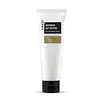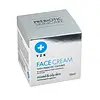What's inside
What's inside
 Key Ingredients
Key Ingredients

 Benefits
Benefits

 Concerns
Concerns

 Ingredients Side-by-side
Ingredients Side-by-side

Water
Skin ConditioningGlycerin
HumectantParaffinum Liquidum
EmollientButylene Glycol
HumectantDipropylene Glycol
HumectantCaprylic/Capric Triglyceride
MaskingSodium Hyaluronate
HumectantButylene Glycol Dicaprylate/Dicaprate
EmollientPolyglyceryl-3 Methylglucose Distearate
EmulsifyingNiacinamide
SmoothingGlyceryl Acrylate/Acrylic Acid Copolymer
HumectantPropylene Glycol
Humectant1,2-Hexanediol
Skin ConditioningCetearyl Alcohol
EmollientPolysorbate 60
EmulsifyingCyclomethicone
EmollientMacadamia Integrifolia Seed Oil
Skin ConditioningButyrospermum Parkii Butter
Skin ConditioningBetaine
HumectantPanax Ginseng Root Extract
EmollientAcanthopanax Senticosus Root Extract
Skin ConditioningPunica Granatum Fruit Extract
AntioxidantCarthamus Tinctorius Flower Extract
Skin ConditioningPanax Ginseng Callus Culture Extract
Skin ConditioningHydrolyzed Collagen
EmollientGanoderma Lucidum Extract
Skin ProtectingGrifola Frondosa Extract
Skin ConditioningPhellinus Linteus Extract
Skin ConditioningFomes Officinalis Extract
Skin ProtectingSarcodon Aspratus Extract
AntioxidantTrametes Versicolor Extract
Inonotus Obliquus Extract
Skin ConditioningAgaricus Blazei Extract
Skin ConditioningTricholoma Matsutake Extract
Skin ConditioningPropolis Extract
Skin ConditioningHydrogenated Lecithin
EmulsifyingSh-Oligopeptide-1
Skin ConditioningCopper Tripeptide-1
Skin ConditioningDimethicone
EmollientArachidyl Alcohol
EmollientBehenyl Alcohol
EmollientArachidyl Glucoside
EmulsifyingPolysorbate 20
EmulsifyingStearic Acid
CleansingPhenoxyethanol
PreservativeArginine
MaskingCarbomer
Emulsion StabilisingPanthenol
Skin ConditioningAllantoin
Skin ConditioningTocopheryl Acetate
AntioxidantAdenosine
Skin ConditioningDisodium EDTA
Xanthan Gum
EmulsifyingEthylhexylglycerin
Skin ConditioningParfum
MaskingWater, Glycerin, Paraffinum Liquidum, Butylene Glycol, Dipropylene Glycol, Caprylic/Capric Triglyceride, Sodium Hyaluronate, Butylene Glycol Dicaprylate/Dicaprate, Polyglyceryl-3 Methylglucose Distearate, Niacinamide, Glyceryl Acrylate/Acrylic Acid Copolymer, Propylene Glycol, 1,2-Hexanediol, Cetearyl Alcohol, Polysorbate 60, Cyclomethicone, Macadamia Integrifolia Seed Oil, Butyrospermum Parkii Butter, Betaine, Panax Ginseng Root Extract, Acanthopanax Senticosus Root Extract, Punica Granatum Fruit Extract, Carthamus Tinctorius Flower Extract, Panax Ginseng Callus Culture Extract, Hydrolyzed Collagen, Ganoderma Lucidum Extract, Grifola Frondosa Extract, Phellinus Linteus Extract, Fomes Officinalis Extract, Sarcodon Aspratus Extract, Trametes Versicolor Extract, Inonotus Obliquus Extract, Agaricus Blazei Extract, Tricholoma Matsutake Extract, Propolis Extract, Hydrogenated Lecithin, Sh-Oligopeptide-1, Copper Tripeptide-1, Dimethicone, Arachidyl Alcohol, Behenyl Alcohol, Arachidyl Glucoside, Polysorbate 20, Stearic Acid, Phenoxyethanol, Arginine, Carbomer, Panthenol, Allantoin, Tocopheryl Acetate, Adenosine, Disodium EDTA, Xanthan Gum, Ethylhexylglycerin, Parfum
Water
Skin ConditioningIsononyl Isononanoate
EmollientDicaprylyl Carbonate
EmollientGlycerin
HumectantBiosaccharide Gum-1
HumectantMacadamia Integrifolia Seed Oil
Skin ConditioningCetearyl Alcohol
EmollientC10-18 Triglycerides
EmollientArachidyl Alcohol
EmollientAmmonium Acryloyldimethyltaurate/Vp Copolymer
Tocopheryl Acetate
AntioxidantAlpha-Glucan Oligosaccharide
CleansingBeheneth-25
CleansingPhenoxyethanol
PreservativeBehenyl Alcohol
EmollientArachidyl Glucoside
EmulsifyingDimethicone
EmollientEthylhexylglycerin
Skin ConditioningTocopherol
AntioxidantDisodium EDTA
Glycine Soja Oil
EmollientParfum
MaskingWater, Isononyl Isononanoate, Dicaprylyl Carbonate, Glycerin, Biosaccharide Gum-1, Macadamia Integrifolia Seed Oil, Cetearyl Alcohol, C10-18 Triglycerides, Arachidyl Alcohol, Ammonium Acryloyldimethyltaurate/Vp Copolymer, Tocopheryl Acetate, Alpha-Glucan Oligosaccharide, Beheneth-25, Phenoxyethanol, Behenyl Alcohol, Arachidyl Glucoside, Dimethicone, Ethylhexylglycerin, Tocopherol, Disodium EDTA, Glycine Soja Oil, Parfum
Ingredients Explained
These ingredients are found in both products.
Ingredients higher up in an ingredient list are typically present in a larger amount.
Arachidyl Alcohol is a fatty alcohol made from peanut oil. It is an emollient, emulsifier, and thickener.
You'll most likely find this ingredient as an emulsifier in water-based cosmetics.
We don't have a description for Arachidyl Glucoside yet.
Behenyl Alcohol is a type of fatty alcohol (these are different from the drying, solvent alcohols).
Fatty Alcohols have hydrating properties and are most often used as an emollient or to thicken a product. They are usually derived from natural fats and oils; behenyl alcohol is derived from the fats of vegetable oils.
Emollients help keep your skin soft and hydrated by creating a film that traps moisture in.
In 2000, Behenyl Alcohol was approved by the US as medicine to reduce the duration of cold sores.
Learn more about Behenyl AlcoholCetearyl alcohol is a mixture of two fatty alcohols: cetyl alcohol and stearyl alcohol. It is mainly used as an emulsifier. Emulsifiers help prevent the separation of oils and products. Due to its composition, it can also be used to thicken a product or help create foam.
Cetearyl alcohol is an emollient. Emollients help soothe and hydrate the skin by trapping moisture.
Studies show Cetearyl alcohol is non-toxic and non-irritating. The FDA allows products labeled "alcohol-free" to have fatty alcohols.
This ingredient is usually derived from plant oils such as palm, vegetable, or coconut oils. There is debate on whether this ingredient will cause acne.
Due to the fatty acid base, this ingredient may not be Malassezia folliculitis safe.
Learn more about Cetearyl AlcoholDimethicone is a type of synthetic silicone created from natural materials such as quartz.
What it does:
Dimethicone comes in different viscosities:
Depending on the viscosity, dimethicone has different properties.
Ingredients lists don't always show which type is used, so we recommend reaching out to the brand if you have questions about the viscosity.
This ingredient is unlikely to cause irritation because it does not get absorbed into skin. However, people with silicone allergies should be careful about using this ingredient.
Note: Dimethicone may contribute to pilling. This is because it is not oil or water soluble, so pilling may occur when layered with products. When mixed with heavy oils in a formula, the outcome is also quite greasy.
Learn more about DimethiconeDisodium EDTA plays a role in making products more stable by aiding other preservatives.
It is a chelating agent, meaning it neutralizes metal ions that may be found in a product.
Disodium EDTA is a salt of edetic acid and is found to be safe in cosmetic ingredients.
Learn more about Disodium EDTAEthylhexylglycerin (we can't pronounce this either) is commonly used as a preservative and skin softener. It is derived from glyceryl.
You might see Ethylhexylglycerin often paired with other preservatives such as phenoxyethanol. Ethylhexylglycerin has been found to increase the effectiveness of these other preservatives.
Glycerin is already naturally found in your skin. It helps moisturize and protect your skin.
A study from 2016 found glycerin to be more effective as a humectant than AHAs and hyaluronic acid.
As a humectant, it helps the skin stay hydrated by pulling moisture to your skin. The low molecular weight of glycerin allows it to pull moisture into the deeper layers of your skin.
Hydrated skin improves your skin barrier; Your skin barrier helps protect against irritants and bacteria.
Glycerin has also been found to have antimicrobial and antiviral properties. Due to these properties, glycerin is often used in wound and burn treatments.
In cosmetics, glycerin is usually derived from plants such as soybean or palm. However, it can also be sourced from animals, such as tallow or animal fat.
This ingredient is organic, colorless, odorless, and non-toxic.
Glycerin is the name for this ingredient in American English. British English uses Glycerol/Glycerine.
Learn more about GlycerinMacadamia Seed oil is an emollient. It is rich in fatty acids: oleic, linoleic, and palmitoleic.
An an emollient, macadamia seed oil helps hydrate the skin by creating a thin film on top. This film prevents moisture from evaporating.
Due to the fatty acid content of this ingredient, it may not be Malassezia folliculitis safe.
Learn more about Macadamia Integrifolia Seed OilParfum is a catch-all term for an ingredient or more that is used to give a scent to products.
Also called "fragrance", this ingredient can be a blend of hundreds of chemicals or plant oils. This means every product with "fragrance" or "parfum" in the ingredients list is a different mixture.
For instance, Habanolide is a proprietary trade name for a specific aroma chemical. When used as a fragrance ingredient in cosmetics, most aroma chemicals fall under the broad labeling category of “FRAGRANCE” or “PARFUM” according to EU and US regulations.
The term 'parfum' or 'fragrance' is not regulated in many countries. In many cases, it is up to the brand to define this term.
For instance, many brands choose to label themselves as "fragrance-free" because they are not using synthetic fragrances. However, their products may still contain ingredients such as essential oils that are considered a fragrance by INCI standards.
One example is Calendula flower extract. Calendula is an essential oil that still imparts a scent or 'fragrance'.
Depending on the blend, the ingredients in the mixture can cause allergies and sensitivities on the skin. Some ingredients that are known EU allergens include linalool and citronellol.
Parfum can also be used to mask or cover an unpleasant scent.
The bottom line is: not all fragrances/parfum/ingredients are created equally. If you are worried about fragrances, we recommend taking a closer look at an ingredient. And of course, we always recommend speaking with a professional.
Learn more about ParfumPhenoxyethanol is a preservative that has germicide, antimicrobial, and aromatic properties. Studies show that phenoxyethanol can prevent microbial growth. By itself, it has a scent that is similar to that of a rose.
It's often used in formulations along with Caprylyl Glycol to preserve the shelf life of products.
Tocopheryl Acetate is AKA Vitamin E. It is an antioxidant and protects your skin from free radicals. Free radicals damage the skin by breaking down collagen.
One study found using Tocopheryl Acetate with Vitamin C decreased the number of sunburned cells.
Tocopheryl Acetate is commonly found in both skincare and dietary supplements.
Learn more about Tocopheryl AcetateWater. It's the most common cosmetic ingredient of all. You'll usually see it at the top of ingredient lists, meaning that it makes up the largest part of the product.
So why is it so popular? Water most often acts as a solvent - this means that it helps dissolve other ingredients into the formulation.
You'll also recognize water as that liquid we all need to stay alive. If you see this, drink a glass of water. Stay hydrated!
Learn more about Water